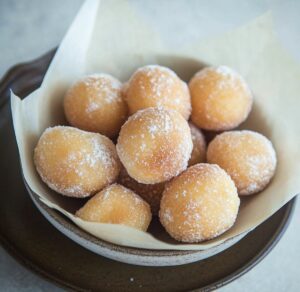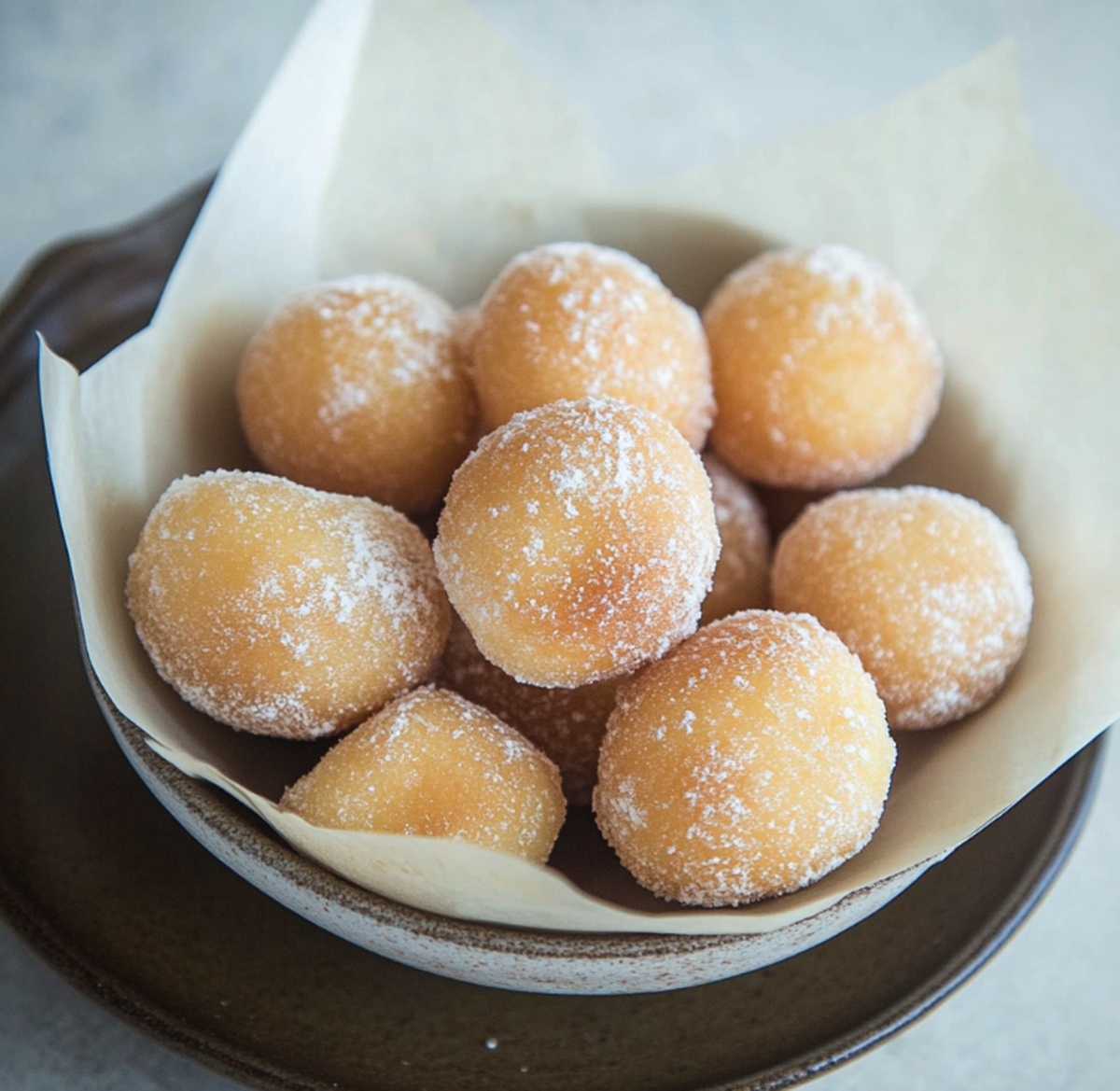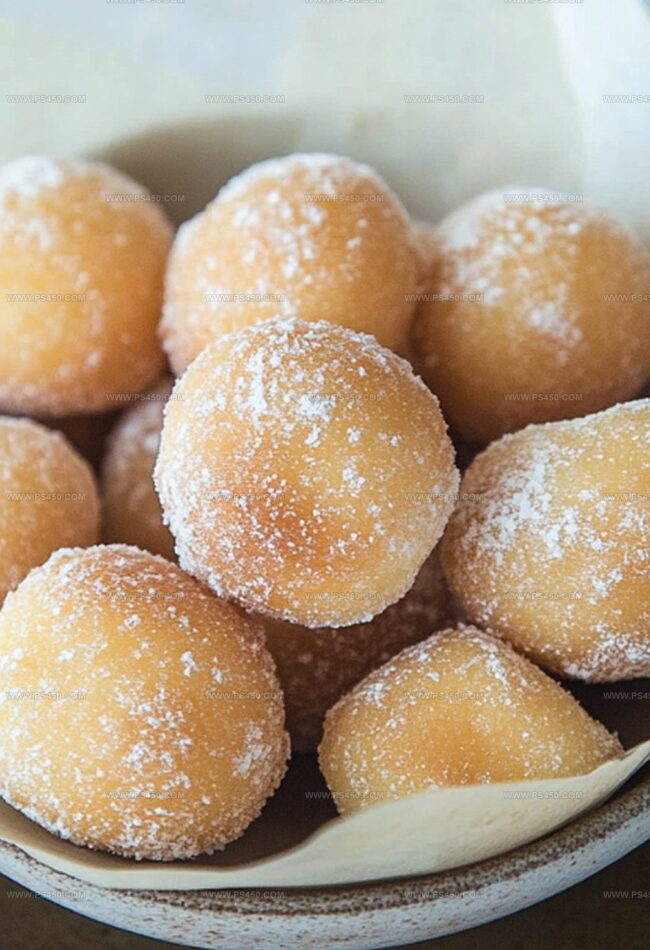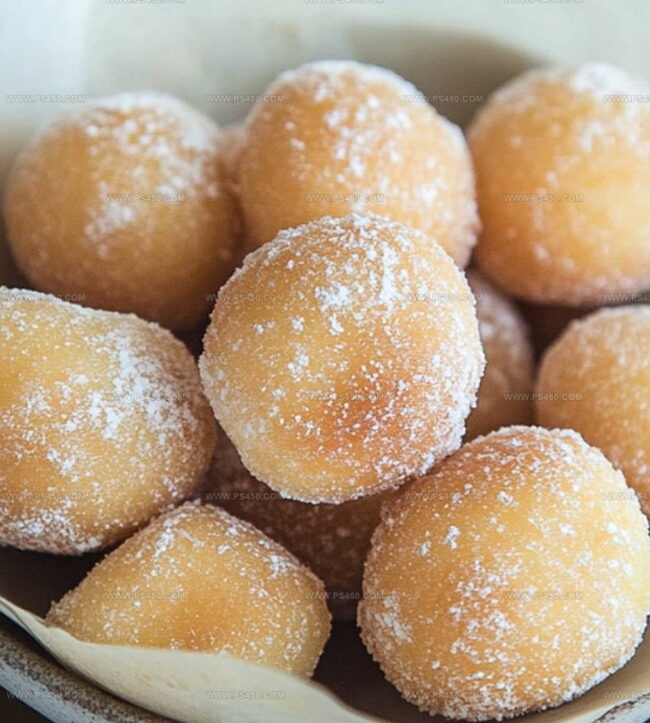Fluffy Portuguese Doughnuts Recipe for Sweet Cravings
Crispy golden malasadas dance with delightful sweetness, promising a Portuguese culinary adventure that captures island traditions.
Sugar-dusted memories whisper of sunny beaches and festive celebrations in the Azores.
Pillowy soft dough transforms into irresistible treats that melt in you mouth with each heavenly bite.
Generations of bakers have perfected this simple yet magical recipe, passing down secrets from kitchen to kitchen.
Traditional techniques blend with pure comfort, creating something more than just a dessert.
Warm, fluffy malasadas invite you to savor a moment of pure joy and cultural connection.
Let these delectable rounds transport you to a world of pure deliciousness.
Why People Enjoy Portuguese Doughnuts (Malasadas)
What You’ll Need For Portuguese Doughnuts (Malasadas)
Main Ingredients:Wet Ingredients:Finishing Ingredients:Steps For Making Portuguese Doughnuts (Malasadas)
Step 1: Activate The Yeast
In a cozy mixing bowl, combine warm water and yeast. Allow the mixture to rest and become wonderfully frothy for about 5-10 minutes. You’ll notice tiny bubbles forming, which signals your yeast is ready to work its magic.
Step 2: Create The Dough Base
In a large mixing bowl, whisk together:Create a small well in the center and pour in the activated yeast mixture. Gently incorporate the liquid into the dry ingredients using a wooden spoon or your hands.
Step 3: Knead The Dough
Transfer the shaggy dough onto a lightly floured surface. Begin kneading with enthusiasm, pushing and folding the dough until it becomes smooth and elastic. This process usually takes about 8-10 minutes of gentle, consistent working.
Step 4: First Rise
Place the kneaded dough in a lightly oiled bowl, covering it with a clean kitchen towel. Let the dough rest in a warm, draft-free spot for approximately 1 hour, or until it doubles in size.
Step 5: Shape The Malasadas
Punch down the risen dough and divide it into equal portions. Roll each portion into a small ball, ensuring they’re smooth and uniform.
Step 6: Second Rise
Arrange the dough balls on a baking sheet, leaving space between each. Cover with a towel and let them rise again for about 30-45 minutes.
Step 7: Deep Fry The Doughnuts
Heat oil in a deep pan or fryer to 350-375°F. Carefully lower the risen dough balls into the hot oil, frying until golden brown on all sides. Work in small batches to maintain oil temperature.
Step 8: Coat With Sweet Goodness
Once fried, transfer malasadas to a paper towel-lined plate to drain excess oil. While still warm, roll them in granulated sugar for that classic sweet coating.
Step 9: Serve And Enjoy
Serve these delectable Portuguese doughnuts immediately. They’re best enjoyed warm, with a cup of coffee or hot chocolate.
Simple Tricks For Portuguese Doughnuts (Malasadas)
How To Store Portuguese Doughnuts (Malasadas)
Best Drinks Or Sweets With Portuguese Doughnuts (Malasadas)
New Ideas For Portuguese Doughnuts (Malasadas)
Questions About Portuguese Doughnuts (Malasadas)
Malasadas are a traditional sweet pastry from Portugal, specifically originated in the Azores islands, and were later popularized in Hawaii by Portuguese immigrants.
Unlike typical doughnuts, malasadas do not have a hole in the center and are typically coated entirely in granulated sugar, giving them a unique, rich texture and sweet finish.
No special baking skills are required. With basic ingredients and simple steps, even beginner bakers can successfully make delicious malasadas by following the recipe carefully and ensuring the yeast is properly activated.
Yeast helps the dough rise, creating a light, fluffy, and soft interior texture that makes malasadas distinct from other fried pastries, giving them their signature airy and delicate consistency.
Print
Portuguese Doughnuts (Malasadas) Recipe
- Total Time: 2 hours 30 minutes
- Yield: 12 1x
Description
Delightful Portuguese Malasadas dance with golden, sugary charm, inviting sweet-toothed enthusiasts into a world of crispy, pillowy indulgence. Warm, fluffy pastries promise a delectable journey through traditional Brazilian bakery magic you’ll savor with pure culinary joy.
Ingredients
Main Ingredients:
- 4 cups (500 g) all-purpose flour
- 3 large eggs
- ¾ cup (180 ml) whole milk, warmed
- ¼ cup (60 ml) warm water
- ¼ cup (60 g) unsalted butter, melted
Leavening and Sweetening Ingredients:
- 2 ¼ teaspoons (1 packet) active dry yeast
- ⅓ cup (70 g) granulated sugar
- ½ teaspoon salt
Flavoring and Cooking Ingredients:
- 1 teaspoon vanilla extract
- 4 cups (950 ml) vegetable oil (for frying)
- 1 cup (200 g) granulated sugar (for coating)
- 1 teaspoon ground cinnamon (optional)
Instructions
- Activate the yeast mixture by combining warm water with dry yeast in a small bowl, allowing it to bloom and become bubbly.
- In a spacious mixing bowl, combine flour, sugar, and a pinch of salt, creating a well in the center for the wet ingredients.
- Pour the frothy yeast mixture into the flour mixture, adding eggs and softened butter to form a smooth, elastic dough.
- Knead the dough thoroughly on a lightly floured surface for 8-10 minutes until it becomes silky and springs back when gently pressed.
- Transfer the dough to a greased bowl, cover with a clean kitchen towel, and let it rise in a warm, draft-free location for approximately 1 hour or until doubled in size.
- Punch down the risen dough and divide it into equal-sized portions, gently shaping each into a round ball.
- Allow the shaped dough balls to rest and proof for an additional 30 minutes, ensuring they become puffy and light.
- Heat vegetable oil in a deep fryer or heavy-bottomed pot to 350°F, maintaining a consistent temperature.
- Carefully lower the dough balls into the hot oil, frying them until they turn golden brown and crispy on all sides.
- Remove the fried doughnuts using a slotted spoon, placing them on paper towels to drain excess oil.
- While still warm, generously coat the malasadas with granulated sugar, ensuring an even, sweet covering.
- Serve immediately, enjoying the warm, pillowy texture of these traditional Portuguese treats.
Notes
- Add a pinch of sugar to the yeast mixture to help activate and speed up fermentation for fluffier doughnuts.
- Use room temperature eggs to ensure smooth incorporation into the dough and consistent texture.
- Consider using a stand mixer with a dough hook for easier kneading and more even gluten development, which results in softer malasadas.
- Test oil temperature with a small piece of dough to ensure perfect golden-brown frying without burning or undercooking.
- Prep Time: 15 minutes
- Cook Time: 15 minutes
- Category: Breakfast, Snacks, Desserts
- Method: Mixing
- Cuisine: Portuguese
Nutrition
- Serving Size: 12
- Calories: 280
- Sugar: 22 g
- Sodium: 150 mg
- Fat: 15 g
- Saturated Fat: 7 g
- Unsaturated Fat: 6 g
- Trans Fat: 0 g
- Carbohydrates: 30 g
- Fiber: 1 g
- Protein: 4 g
- Cholesterol: 60 mg




Emily Morgan
Food Critic & Kitchen Tips Specialist
Expertise
Global Food Exploration & Critique, Simple Kitchen Hacks & Time-Saving Tips, Presentation & Plating Techniques, Culinary Research & Storytelling.
Education
New York University
Emily Morgan has journeyed across the globe, collecting culinary secrets that turn everyday ingredients into impressive meals.
Based in Seattle and armed with a Journalism degree from NYU, she blends thorough research with a flair for presentation, ensuring every dish looks just as good as it tastes.
Focusing on fresh flavors, simple methods, and a bit of fun, Emily shows home cooks how to elevate their daily cooking without fancy gadgets or complex steps.